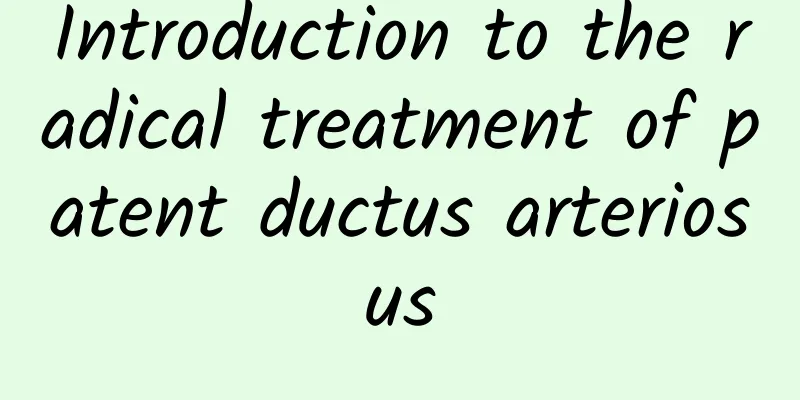Introduction to the radical treatment of patent ductus arteriosus

|
What is the radical cure for patent ductus arteriosus? Patent ductus arteriosus is a common congenital cardiovascular malformation. Some children with patent ductus arteriosus can recover on their own without treatment, but there are still many children with patent ductus arteriosus who need treatment to recover. So, what are the radical cures for patent ductus arteriosus? Patent ductus arteriosus that does not necessarily require treatment For patent ductus arteriosus with an ultrasound-measured diameter of less than 2 mm and no obvious auscultatory murmur, it indicates that the shunt volume is very small and it is a "silent" ductus arteriosus, which will not have an adverse effect on the child and does not require treatment. For those with no continuous murmur on auscultation but a relatively obvious systolic murmur and no change in follow-up for more than one year, it means that there is still a considerable shunt volume and treatment needs to be considered as appropriate. Drug closure of patent ductus arteriosus Generally, it is suitable for premature infants with patent ductus arteriosus. The drugs that can be used include anti-inflammatory and analgesic drugs such as indomethacin and ibuprofen. The effect is better when used in the early stage (within 72 hours after birth). The effect of application in full-term infants is generally poor. Special circumstances requiring patency of the ductus arteriosus Some complex congenital heart malformations rely on the patency of the ductus arteriosus to maintain the life of the child. For example, pulmonary atresia or severe pulmonary artery stenosis can be treated with drugs (prostaglandins) or interventional stent placement to keep the ductus arteriosus open. Interventional treatment Except for the window-type ductus arteriosus, all other types of patent ductus arteriosus can be treated with cardiac catheterization. Generally, the patient must be over 6 months old and weigh more than 8 kg; in special cases, 4-8 kg is also acceptable. The disadvantage is that it is radioactive (equivalent to a CT scan). Surgery It is suitable for all types of patent ductus arteriosus and does not require extracorporeal circulation. The disadvantage is that it is still somewhat traumatic. |
<<: How to identify patent ductus arteriosus
>>: What are the effective methods for treating patent ductus arteriosus?
Recommend
How to treat polio
Polio is an acute infectious disease caused by th...
What are the precautions for polio patients?
Poliomyelitis is also known as poliomyelitis. In ...
What medicine can children take to get better quickly from acute mumps?
Children with acute mumps usually need to choose ...
What are the examination items for mumps
Many people have had similar experiences, that is...
What medicine should children take for runny nose? Children can use these medicines for runny nose
Children often have runny noses in daily life, bu...
When is the best time to take medicine for hand, foot and mouth disease?
When is the best time to take medicine for hand, ...
Causes of diarrhea in children
What parents worry about most is that their child...
How to treat allergic eczema in children How to care for allergic eczema in children
Children's allergic eczema is generally treat...
What are the symptoms of ADHD in children?
ADHD, also known as attention deficit hyperactivi...
What are the symptoms of patent ductus arteriosus in newborns?
Patent ductus arteriosus is a congenital heart di...
Mumps is the worst day
Mumps is usually most severe on the third day, so...
How to treat a child who coughs and spits white foamy sputum?
If a child coughs and spit out white foamy sputum...
How to cure pneumonia in children
Neonatal pneumonia is a very common disease. The ...
What are the diagnostic criteria for polio?
Polio is an infectious disease caused by the poli...
What are the symptoms of hand, foot and mouth disease in children? 4 examination items for hand, foot and mouth disease in children
Hand, foot and mouth disease is a common disease ...









